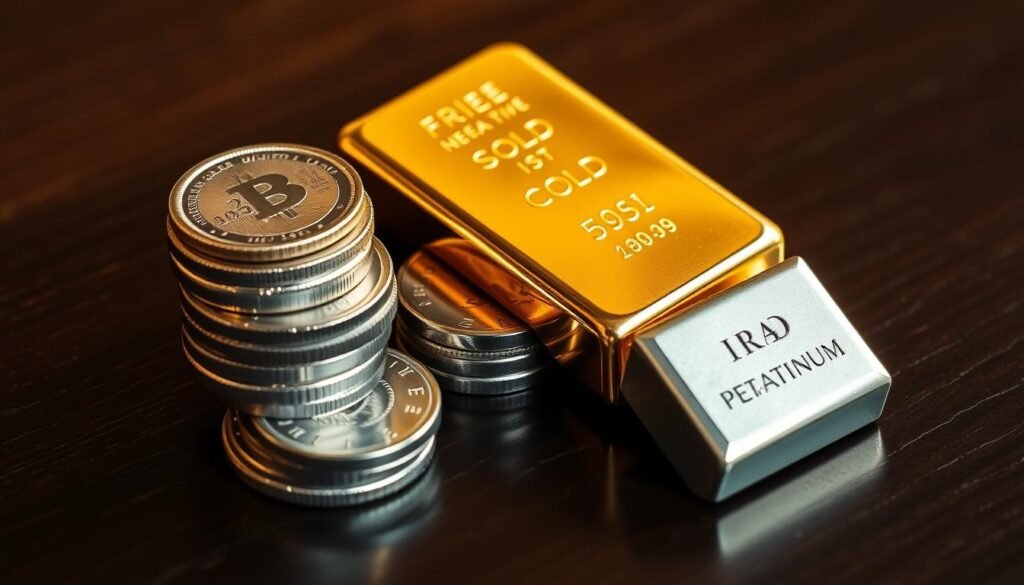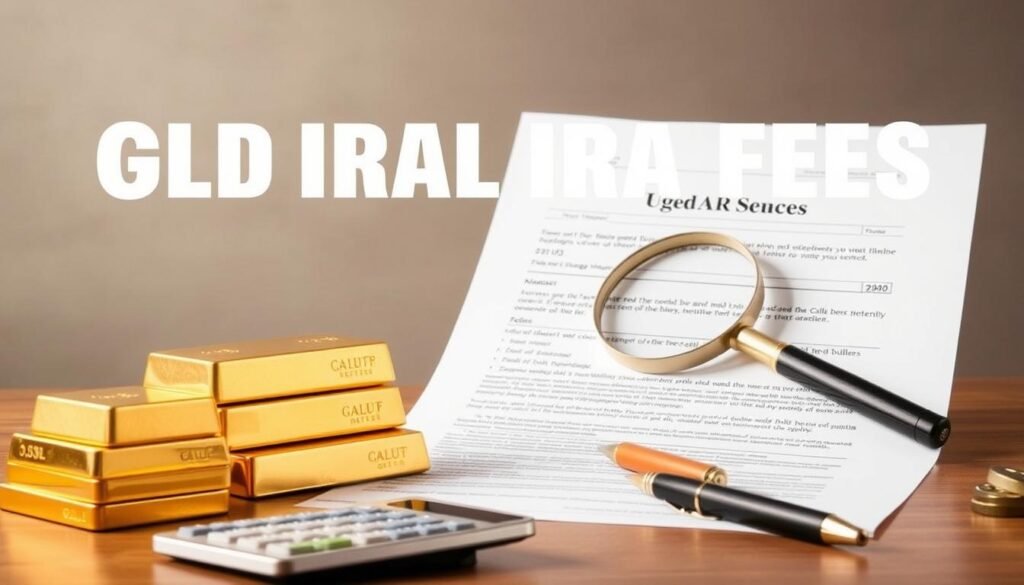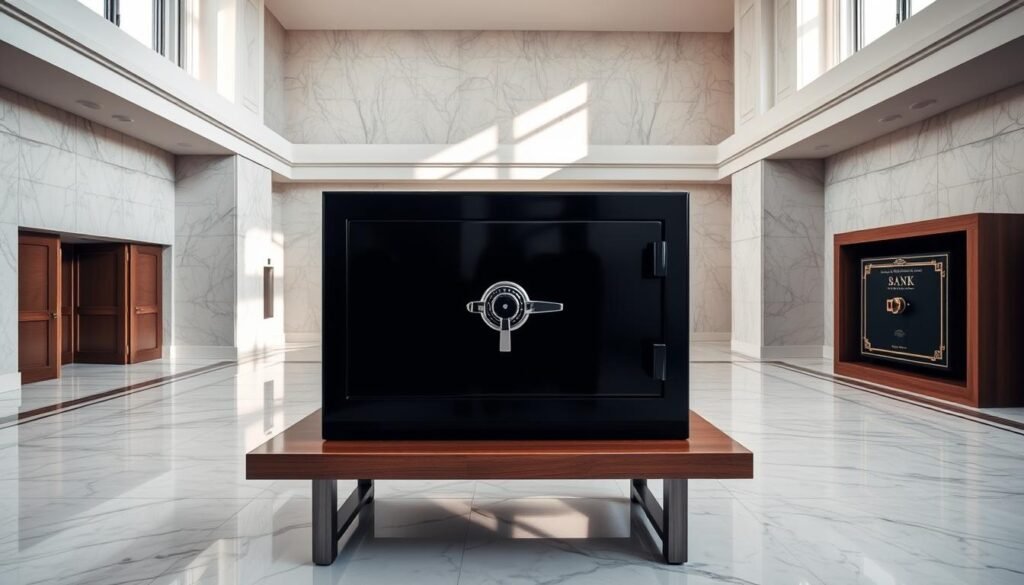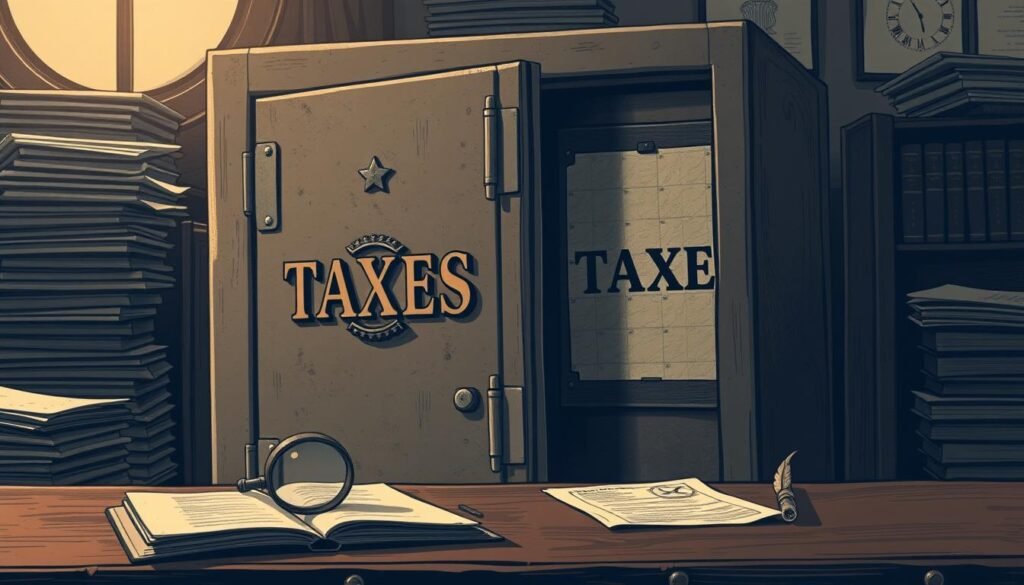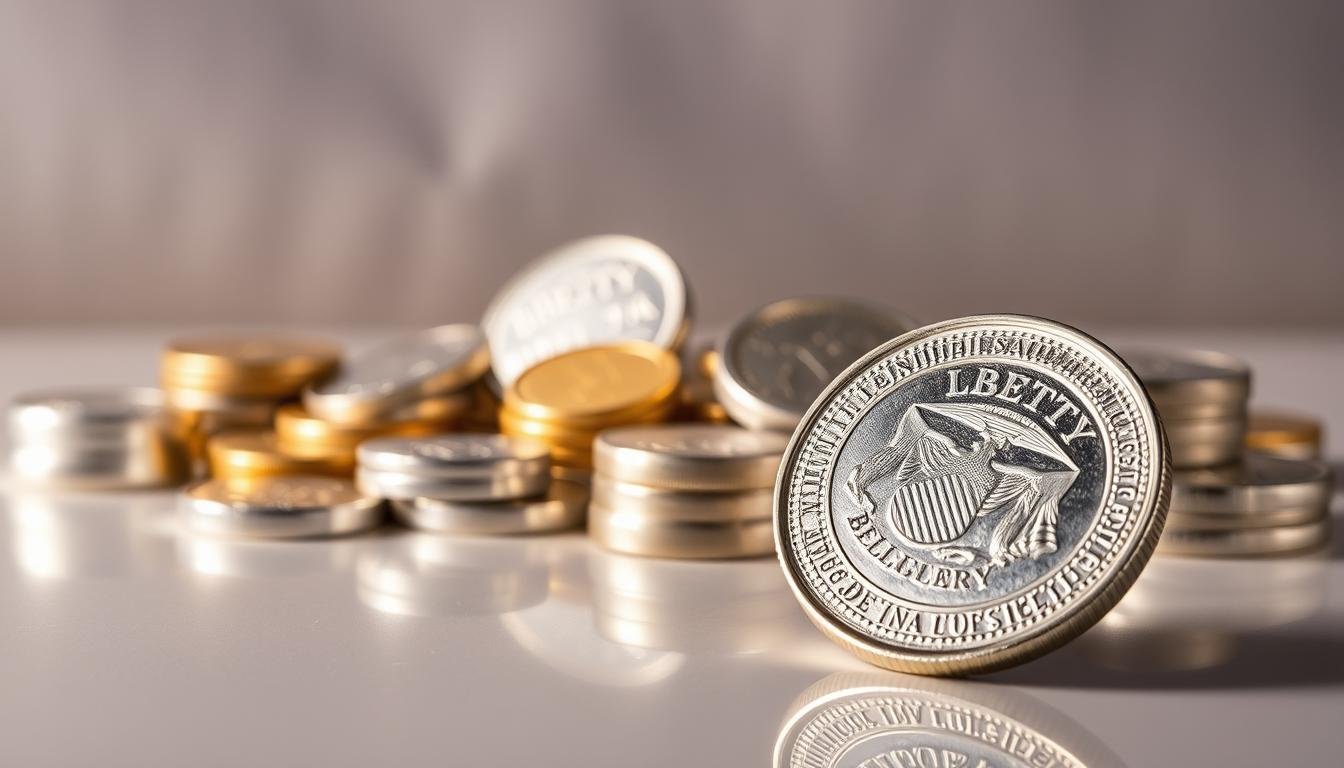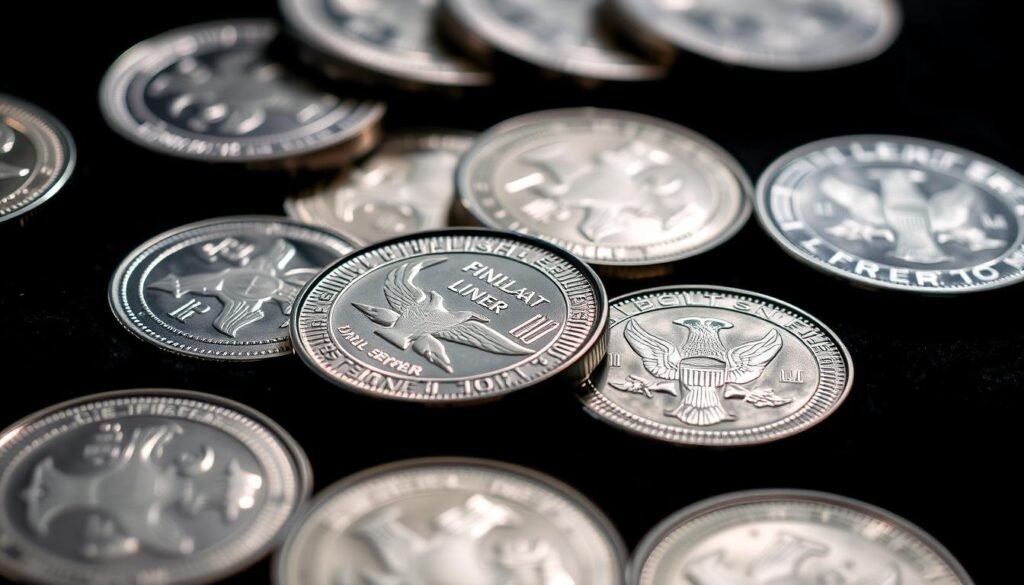Surprising fact: more than half of investors who request delivery of metals treat that step as a full distribution, which can trigger taxes and penalties if handled incorrectly.
A Gold IRA is a self-directed retirement account that holds physical metals with the same tax advantages as standard accounts. Rules require an IRS-approved custodian and an approved depository to hold your metals until a qualified distribution.
You can take distributions two ways: instruct your custodian to liquidate to cash, or request metals in-kind. Each choice affects shipping, fees, and tax treatment.
Know this: home storage before a qualified distribution counts as a distribution and may incur income tax and a 10% penalty if you are under 59½. Expect extra costs for setup, storage, insurance, and dealer spreads when you add precious metals to your plan.
This article will show when coins ship, how shipping and storage work, and the practical steps to open, fund, and instruct your custodian to buy IRS-approved metals that meet purity and packaging rules.
Key Takeaways
- Distributions can be in-kind (metals) or cash; each has different tax and shipping rules.
- Metals must stay at an approved depository until a qualified distribution occurs.
- Taking delivery improperly may trigger income tax and a 10% penalty if under 59½.
- Expect fees for setup, storage, insurance, and dealer spreads that affect returns.
- Use a specialty custodian and check provider minimums, fees, and service before you commit.
What this article covers for U.S. investors today
Many U.S. investors want to know exactly how distribution and delivery work when physical metals are involved.
Do they ship coins to you? We explain whether Gold IRA companies ship coins at distribution, how in-kind delivery works, and when custodians instead liquidate holdings for cash.
Rules to note: distributions are penalty-free at age 59½ and older. Early withdrawals generally trigger a 10% penalty. Custodians arrange storage at IRS-approved depositories like Delaware Depository or IDS of Texas, and metals stay off your property until a qualified distribution.
- Preview taxes for traditional and Roth Gold IRA distributions, and how reporting differs when you take metals or cash.
- Summarize storage: who holds title, where metals live, and what changes when you take delivery.
- Outline common fees, dealer spreads, and service trade-offs so investors can compare providers.
- Flag contribution limits, funding options, product roundups, and market context to guide allocation decisions.
- Call out IRS purity, packaging, custodian, and depository requirements that affect eligibility.
Scope: This piece focuses on U.S. tax rules and investor protections as they stand today, and it offers practical steps and comparisons to help you evaluate your options.
Gold IRA basics: how a self-directed individual retirement account holds precious metals
Not all coins or bars qualify for retirement accounts; the IRS sets clear product and custody rules.
What it is: A Gold IRA is a self-directed individual retirement account that lets investors hold physical precious metals while keeping traditional tax benefits.
IRS-approved metals, purity and packaging requirements
The account accepts specific metals: gold, silver, platinum, and palladium. For bullion, the IRS generally requires high purity—about 0.995 fine for most gold bars and many coins.
Some coins, like American Eagles, are an accepted exception even when their purity differs from bars because they meet mint and refiner standards. Metals must usually arrive in original packaging from approved refiners or mints.
Why an IRS-approved custodian and depository are mandatory
The custodian is an IRS-approved institution that executes purchases, verifies product eligibility, and handles reporting. They arrange delivery to an approved depository rather than to your home.
Depositories offer segregated or non-segregated storage. Segregated means specific bars or coins are held separately for your account. Non-segregated means pooled holdings with receipts for ownership.
Important: keeping metals at home or in a personal safe counts as a distribution. That can trigger income tax and a 10% penalty if you are under 59½.
The custodian vets each purchase, maintains chain-of-custody paperwork, and coordinates ongoing storage and insurance with the depository. Bars and coins carry different premiums and liquidity, so consider both when buying.
For a practical overview of account rules and product eligibility, see what qualifies. For a balanced look at downsides, review common negatives.
Gold IRA distribution rules at a glance
Distribution rules set the timing and tax impact when you move physical metals from a retirement account.
Age 59½ and early-withdrawal penalties
After age 59½ you may take distributions without the 10% early penalty. That applies whether you request cash or ask for in-kind delivery of metals.
If you withdraw before 59½, expect a 10% penalty plus ordinary income tax on the distribution unless you qualify for an exception.
Required minimum distributions for traditional accounts
Traditional plans require RMDs starting at the age set by law. You can satisfy an RMD by selling metals for cash or by receiving physical items valued at fair market price.
Custodians report distributions to the IRS and issue tax forms for both cash and in-kind moves. The taxable amount is the metal’s fair market value at distribution.
“Document basis and distribution values carefully—good records protect you from surprises.”
Fees and logistics: distributions can trigger shipping, handling, insurance, or transaction spreads. Plan RMD timing with market liquidity and pricing, especially for concentrated holdings.
Do Gold IRA companies ship coins to you at distribution?
Receiving physical coins at distribution is possible, yet it requires careful coordination with your custodian and depository. Your metals remain under custody until you request a qualified distribution, so delivery is a formal process—not an instant transfer.
In-kind delivery vs. selling for cash
In-kind delivery means the depository ships coins or bars to you after the custodian approves the move. Expect handling, insurance, and carrier signature requirements.
Selling for cash is simpler for many investors. The custodian liquidates holdings and sends a cash distribution, avoiding shipping logistics and some fees.
Home delivery risks, taxes, and custody rules
Taking possession before a qualified distribution breaks custody rules and may trigger income tax and a 10% penalty if under 59½. Always coordinate timing to avoid missteps.
- Typical fees: depository handling, shipping, insurance, plus any custodian processing charges.
- Valuation: in-kind distributions are reported at fair market value on the distribution date.
- On receipt: keep ID ready, sign for delivery, and document weights, serial numbers, and condition.
Plan ahead: decide on in-kind versus cash well before distribution, confirm costs with your custodian, and record everything when the shipment arrives.
How storage works before and after you take a distribution
Before distribution, your custodian books purchases into an IRS-approved, insured depository. The depository provides audit controls and insurance to safeguard your assets until a qualified distribution.
Most providers offer segregated or non-segregated storage. Segregated means specific bars or coins are set aside for you. Non-segregated pools holdings and can lower costs but may complicate identification.
Your custodian and the depository send statements and reconciliation reports that show holdings, location, and serial numbers. These records meet IRS requirements and help with insurance or future sales.
- Storage fees: flat vs. value-based billing and different billing cycles.
- Service levels: basic insurance, periodic audits, and access protocols vary by provider.
- Practical moves: insured shipping is available if you transfer between depositories.
After an in-kind distribution, you control physical possession and must arrange secure storage—insured home safes or private vaults are common. Remember, during the life of the account the metals must remain in approved custody to keep tax benefits.
Some retirees choose to sell for cash or keep holdings at the depository to avoid handling. Compare security, access, and customer service when weighing your storage options, and keep paperwork for insurance and resale.
Taxes on Gold IRA distributions
Understanding tax treatment before you request delivery prevents costly surprises at filing time.
Traditional vs. Roth treatment
How traditional distributions are taxed
Distributions from a traditional account count as ordinary income. That rule applies whether you take cash or receive metals in-kind. Early withdrawals generally add a 10% penalty unless an IRS exception applies.
Roth qualified distributions
Qualified Roth distributions—meeting age and holding requirements—are usually tax-free. This can be a major planning advantage when managing retirement cash needs.
Reporting and valuation
Custodians report distributions to the IRS. In-kind moves are valued at fair market price on the distribution date. Keep records of dates, serial numbers, and fees to support reported values.
“Document basis, distribution dates, and fees—good records simplify tax filing.”
- State taxes may apply—plan estimated payments for large moves.
- Inherited accounts follow different rules; beneficiaries should consult custodial guidance.
- Consider professional tax help for multi-lot or complex reporting scenarios.
Fees and markups you’ll encounter with precious metals IRAs
Real ownership costs go beyond purchase price and show up as ongoing account charges.
Setup fees are usually a one-time charge near $50. Annual administration runs about $75–$125. Storage and insurance typically add $100–$150 a year, depending on the depository and service level.
Markups and spreads over COMEX spot vary by coin and bar. Numismatic pieces carry higher spreads; stick to approved bullion to control cost. Ask the custodian for current buy and sell prices to see how the dealer spread affects your all-in price.
| Charge type | Typical range | What it covers |
|---|---|---|
| Setup fee | $25–$75 | Account opening and paperwork |
| Annual admin | $75–$125 | Custodial reporting and service |
| Storage / insurance | $100–$150 | Depository storage, audits, insurance |
| Markup / spread | Varies by product | Dealer premium over spot for coins & bars |
Compare total cost: some companies waive fees for large balances. Check sample invoices and buyback policies. Strong customer service can cut exit costs when you sell or request delivery.
Gold IRA contribution limits and funding options
Funding a metals-backed retirement account requires choices that affect taxes and timing.

For 2024 the contribution limit is $7,000. Those aged 50 and over may add a $1,000 catch-up. These limits apply whether you fund with cash or move assets into a Gold IRA.
Common funding options include trustee-to-trustee transfers, rollovers from a 401(k), and direct cash contributions within annual contribution rules.
Note: the one-rollover-per-12-months rule applies to IRA-to-IRA rollovers. Many investors choose direct transfers to avoid withholding and timing problems.
Specialty custodians handle metals accounts and paperwork; standard brokerages rarely offer this service. Processing times vary—expect days to weeks for rollovers.
- Prepare recent statements and employer plan data to speed transfers.
- Establish an investment policy before funding so your custodian can act swiftly.
- Confirm plan-specific rules to avoid surprises when you request a distribution.
Tip: coordinate contributions with tax planning—traditional gives deductions now; Roth favors long-term tax-free growth.
Gold IRA
A metals-backed retirement account lets you hold tangible assets inside a tax-advantaged wrapper.
What it is: A Gold IRA holds approved coins and bars within the same contribution and distribution rules as other ira accounts. You may open traditional, Roth, or SEP types, and tax treatment follows each structure.
Primary benefits include diversification, a potential inflation hedge, and a physical store of value that is separate from stocks and bonds.
Main trade-offs: holding physical gold brings higher fees for storage and administration, and it often has different liquidity than ETFs or miner shares.
Keep only IRS-approved bullion—not collectibles—to stay compliant. Factor ongoing costs into long-term performance expectations when sizing an allocation.
| Feature | How it affects you | Considerations |
|---|---|---|
| Account types | Traditional, Roth, SEP | Pick based on tax goals and retirement timeline |
| Costs | Setup, storage, insurance, dealer spreads | Reduce allocation if fees erode expected returns |
| Liquidity | Slower than ETFs; physical handling required | Plan distributions and sell timing in advance |
Compare custodians for fee transparency, buyback policies, and customer service before you commit.
What to consider before choosing a custodian and depository
Choosing the right custodian shapes fees, storage options, and how smoothly you access assets. Start by confirming IRS-approved custodian status and clear fee schedules. Ask whether the provider works with multiple depositories such as Delaware Depository or IDS of Texas.
Compare companies on transparency, online account access, customer service responsiveness, and buyback procedures. Verify storage choices: segregated versus non-segregated, insurance limits, and audit frequency at each depository.
- Must-have qualifications: IRS approval, published fees, and multiple depository options.
- Costs: ask about markups, spreads, and how pricing is quoted relative to spot to avoid surprises.
- Reporting: confirm timely tax forms, accurate year-end statements, and clear record keeping.
- Agreements: review liquidation, distribution, and shipping protocols before you commit.
“Total cost matters more than first-year promotions—plan over your expected holding period.”
Product Roundup: best gold IRA companies right now
Compare these trusted providers to find the best mix of price, support, and custodian options for your purchase plan.
Birch Gold Group — Clear fee disclosure with a $50 setup, ~$100 storage/insurance, and $125 management. Recommended $10,000 minimum and first-year fees covered on larger accounts make it strong for cost-focused shoppers.
Goldco — No minimum purchase required. Typical charges include $50 setup, $80 admin, and $100–$150 storage. Live chat and a highest buy-back price guarantee help flexible entry-level investors.
American Hartford Gold — Geared to experienced investors: $10,000 minimum, tiered annual fees ($75–$125), free shipping, and strong ratings for reliability.
American Bullion — $10,000 minimum, $25 setup, and $160 annual account fee. First-year storage free on $50k+ and Delaware Depository storage monitored 24/7.
Monetary Gold — Concierge-style support with 24/7 assistance, $5k–$10k minimums by custodian, and scalable $100 annual storage up to $100k.
Augusta Precious Metals — Best for large deposits: $50,000 minimum, $50 application, $125 custodian fee, $100 storage, plus lifetime support and strong educational materials.
Tip: Verify current fees, buyback terms, and custodian options directly with each provider before you open an account.
| Provider | Min. Purchase | Notable fees / perks |
|---|---|---|
| Birch Gold Group | $10,000 | $50 setup; first-year fee coverage >$50k |
| Goldco | None | Live chat; buy-back guarantee |
| American Hartford Gold | $10,000 | Tiered annual fees; free shipping |
Action: Shortlist 2–3 companies based on your purchase size, preferred custodian, and expected fees, then schedule consultations to compare onboarding and distribution handling.
Compare popular Gold IRA providers and minimums
Not all firms ask for the same opening balance, so your starting capital shapes who you can work with.

Quick snapshot: APMEX $2,000; Orion Metal Exchange $10,000; Birch Gold Group $10,000; Monetary Gold $5,000–$10,000.
Zero-minimum options include Silver Gold Bull, American Bullion, JM Bullion, Lear Capital, Advantage Gold, and Goldco. These can suit small purchases and simpler onboarding.
- Weigh minimums against fees, price transparency, product availability, and support hours.
- BBB ratings and screened firms add consumer confidence when choosing companies and custodial partners.
- Compare price relative to market spot—higher premiums can erase savings from low minimums.
- Ask about custodian partnerships, storage options, buyback policies, and settlement times.
Pro tip: get written quotes for purchase spreads and total account costs. That makes it easy to compare true out‑the‑door price and service options before you commit.
How to open and fund a Gold IRA from your existing retirement accounts
Opening a metals-backed retirement account from an existing plan is straightforward when you follow a clear checklist. Pick a firm with transparent fees, good BBB/BCA ratings, and named depository partners before you start.
Transfers, rollovers from 401(k), and cash contributions
Fund the new account via a trustee-to-trustee transfer, a direct rollover from a 401(k), or a cash contribution within annual limits. Gather recent statements, plan numbers, and trustee contact info to speed processing.
Direct transfers avoid withholding and tax risk. Indirect rollovers can work, but watch the 60-day rule to prevent taxable events. Ask the custodian about typical timing for each option.
Directing your custodian to purchase IRS-approved coins and bars
After funding, instruct the custodian to place the purchase. Specify approved items that meet IRS purity requirements (99.5%+ where required). Compare multiple quotes and confirm spreads, storage, and shipping fees before you authorize payment.
- Settlement: the custodian coordinates payment and delivery to an IRS-approved depository such as Delaware Depository or IDS of Texas.
- Records: you’ll receive account updates, serial numbers, and statements once holdings are booked.
- After care: keep a written investment policy, set rebalancing triggers, and schedule a post-purchase check to verify receipt.
“Confirm online access and clear service escalation paths to resolve any funding or purchase delays.”
Pros and cons of holding physical gold in retirement accounts
Adding physical gold to a retirement plan offers clear diversification but comes with trade-offs you should know.
Benefits include portfolio diversification, a potential inflation hedge, and the comfort of tangible assets. Holding metal can reduce counterparty risk versus paper proxies.
Drawbacks are real: higher fees for purchase and storage, shipping logistics, and dealer premiums that push your effective entry and exit price above spot.
Volatility patterns matter. Metals may rise in crises but can lag equities during long growth phases, which hurts compounding returns for long-term investors.
- Premiums and spreads directly affect realized price when you buy or sell.
- Liquidity varies: common bullion coins trade easily; large bars can be slower to move.
- Rebalance periodically to keep metal exposure aligned with goals.
Bottom line: treat physical metal as a strategic option, not a core growth engine. Blend it with stocks and bonds, set clear objectives, and limit exposure so you don’t sacrifice long-term gains for short-term comfort.
Alternatives to Gold IRAs for gold exposure and diversification
If you want metal exposure without handling bars, paper options can deliver similar market exposure with fewer logistics.
Simple routes: hold ETFs (for example, SPDR Gold Shares) or mining equities inside a traditional or Roth retirement account. These options remove storage, insured shipping, and depository rules.
Why choose paper? Lower ongoing fees and easier liquidity make it easier to rebalance and sell quickly when market conditions change.
Diversify further: consider silver funds, commodity baskets, REITs, or Treasurys as complementary investments. A core-satellite approach keeps broad index funds as the core and uses commodity exposure as a tactical satellite.
| Type | Typical fees | Liquidity | Key trade-offs |
|---|---|---|---|
| ETF (gold & silver) | Expense ratio 0.2%–0.6% | High — trades intraday | Tracking error, counterparty & sponsor risk |
| Mining stocks | Broker commissions; no storage cost | High — market trading | Operational risk, leverage to metal price |
| Physical bullion account | Storage & insurance $100+/yr | Lower — shipping & verification delays | Storage cost, custody rules, higher premiums |
Tax and planning note: ETFs inside an account simplify reporting versus in-kind physical distributions. Evaluate expense ratios, sponsor reputation, and fund liquidity before you invest.
“Paper solutions often suit investors who prioritize simplicity and lower ongoing costs.”
Action tip: stress-test scenarios for rate changes, inflation spikes, and liquidity stress. Choose the investment type that matches your risk profile and time horizon.
Risk and performance context: metals vs. the broader market
Over long cycles, stocks have tended to outpace hard assets in average returns. Equities generally deliver higher compound gains than bullion across full market cycles.
How metals behave: the price of bullion often spikes during crises or when inflation expectations rise. That creates a different risk-return pattern than the broad market.
Practical points for retirement planning: a small allocation can dampen sequence-of-returns risk early in retirement. Metals do not pay dividends, so gains rely solely on price moves.
- Correlations shift — bullion may hedge at times but lag in long bull markets.
- Tax deferral inside an account helps with rebalancing and timing sales.
- Behavioral benefit: some investors stay the course with a modest metals stake.
“Diversify to capture market growth while using hard assets as a stabilizer.”
| Factor | Equities | Metals |
|---|---|---|
| Long-term returns | Higher on average | Mixed; spikes in crises |
| Income | Dividends possible | None — price appreciation only |
| Role in portfolio | Core growth | Risk dampener / hedge |
Action: align exposure with your time horizon and liquidity needs, and document metals’ place in your investment policy. For a balanced review of risks and benefits, see risks and rewards.
Conclusion
A careful plan for delivery, taxes, and storage keeps surprises out of your retirement years.
You can receive coins or bars shipped to you via an in-kind distribution, or you can sell holdings and take cash. A Gold IRA preserves tax benefits only when IRS-approved custody rules and depository storage are followed.
Think through trade-offs: physical holdings offer diversification and tangible benefits but bring higher ongoing fees and handling logistics. Compare providers for clear pricing, buyback policies, and service before you purchase.
Document values, serial numbers, and shipping receipts when you take delivery. Start with a right-sized allocation in your retirement savings, use rollovers or transfers to fund the account efficiently, and review fee structures annually.
Next step: shortlist providers, ask detailed questions about storage and distribution, and move forward with a written plan for taxes and delivery.
FAQ
Can my custodian ship coins to me when I take a distribution?
In most cases, custodians and depositories do not ship physical coins directly to an account holder for standard distributions. Instead, you can request an in-kind distribution where approved bullion is transferred out of the retirement account into personal ownership; the custodian coordinates release through an approved depository. Many firms prefer to sell the holdings for cash and send a check or transfer, since shipping to a home can trigger tax, custody, and insurance issues.
What is an in-kind distribution and how does it differ from a cash distribution?
An in-kind distribution moves the actual approved metal bars or coins from the retirement account into your name without selling. A cash distribution sells the assets within the account and sends you the proceeds. In-kind can avoid immediate market sale, but it requires meeting IRS and custodian rules plus often paying distribution fees and arranging secure storage if you keep the items.
Are there age rules or penalties for taking physical assets from a retirement account?
Yes. Withdrawals before age 59½ typically face a 10% early withdrawal penalty on top of regular tax for traditional accounts. Taking physical assets as a distribution follows the same rules: unless you qualify for an exception, you may owe the penalty and ordinary income tax on the taxable portion at distribution.
Can I have metals mailed to my home if I take a distribution?
Most custodians and depositories prohibit direct home delivery for retirement-account-held metals because of IRS custody rules and insurance concerns. If a firm does allow delivery, expect strict ID checks, higher shipping and insurance costs, and potential tax complications. Many investors instead arrange delivery from a dealer after an after-tax cash distribution.
What IRS-approved metals can be held and distributed from a self-directed account?
The account can hold coins and bars that meet IRS requirements for purity and provenance. Acceptable pieces often include U.S. bullion coins and certain investment-grade rounds and bars in specific purities. Your custodian will list eligible items and ensure they meet packaging and assay standards before accepting them into custody.
Who must hold custody and storage for retirement-account metals before a distribution?
The IRS requires an approved third‑party custodian and an approved depository or storage provider to hold physical holdings. You cannot personally hold the metal while it’s in the retirement account. The custodian handles recordkeeping, and the depository provides insured storage until a permissible distribution occurs.
How are distributions from a traditional account taxed compared with a Roth account?
For traditional accounts, distributions are generally taxable as ordinary income in the year taken. For Roth accounts, qualified distributions are tax-free if the account meets the five-year rule and you are over 59½. Non-qualified Roth distributions can be subject to taxes on earnings and possibly penalties.
Will I owe collectible taxes if I take physical bullion from my retirement account?
Metals held inside a retirement account follow retirement tax rules, not collectible tax rates, while inside the account. Once distributed and sold outside the account, capital gains and collectible tax rules may apply depending on the type of metal and holding period. Consult a tax advisor for personal scenarios.
What fees should I expect when liquidating or taking a distribution of physical holdings?
Expect setup and administration fees from the custodian, distribution fees, storage/insurance charges prorated to the distribution date, and dealer markups or spreads if assets are sold. Some firms also charge shipping and handling if physical delivery is allowed. Compare providers for transparency on each cost.
Can I roll over a 401(k) into a self-directed account holding physical assets?
Yes. You can roll funds from a 401(k) or traditional IRA into a self-directed account that purchases approved precious metals. Use a trustee-to-trustee transfer or direct rollover to avoid taxes and penalties. Then instruct your custodian to purchase IRS-approved bars or coins per account rules.
How do I choose a custodian and depository for holding physical metals in retirement accounts?
Look for firms with clear fee schedules, reputable depositories, FDIC-style insurance or private insurance policies, strong customer service, and transparent buying/selling markups. Review reviews for companies such as Birch Gold Group, Goldco, and American Bullion to compare strengths in transparency, minimums, and education.
Are there contribution limits or funding options for a self-directed precious metals account?
Contribution limits follow standard retirement-account rules — for example, IRA contribution limits set annually by the IRS. Funding can come from cash contributions, rollovers from 401(k)s, or transfers from other IRAs. Custodians typically handle the paperwork to direct purchases of approved items once funds clear.
What storage options exist after I take a distribution of physical metal?
After a distribution, you can store assets in private secure storage, third‑party vaults, or home safes. Each option has tradeoffs: private vaults offer insurance and security but cost more; home storage gives control but increases theft risk and may complicate insurance and resale. Consider insured depositories for ongoing protection.
How do market prices and dealer markups affect my decision to take physical assets?
Dealer markups and bid-ask spreads affect proceeds when selling assets and the cost when buying. If you request an in-kind distribution, the market value at distribution determines any taxable amount. Factor in storage, insurance, and potential markup costs when deciding whether to distribute in-kind or sell for cash.
What practical steps should I take before requesting a distribution of physical holdings?
First, confirm eligibility and tax consequences with your custodian and a tax advisor. Verify the depository’s process, distribution fees, and whether an in-kind release is allowed. Arrange secure storage if you plan personal ownership, and request written estimates for all fees and taxes before proceeding.



